Category: Recommended Reading
Caravaggio Made Darkness Visible
Ed Simon at Hyperallergic:
 When the water-logged, bloated corpse of the drowned Maddalena Antognetti, a sex worker who used the name “Lena,” was dredged from Rome’s Tiber river in the summer of 1604, she was still beautiful. We know this because her sometimes-lover Michelangelo Merisi, who hustled under the name Caravaggio, used Lena’s dead body as a model in a masterpiece entitled “Death of the Virgin.”
When the water-logged, bloated corpse of the drowned Maddalena Antognetti, a sex worker who used the name “Lena,” was dredged from Rome’s Tiber river in the summer of 1604, she was still beautiful. We know this because her sometimes-lover Michelangelo Merisi, who hustled under the name Caravaggio, used Lena’s dead body as a model in a masterpiece entitled “Death of the Virgin.”
Completed around 1606 and now at the Louvre, the oil-on-canvas painting transubstantiates Lena into a red-tunicked Virgin Mary, sprawled in a cruciform position atop a gathering of sheets and pillows while an assemblage of apostles mourns around her. A composition such as “Death of the Virgin” is a representative example of Caravaggio’s brilliance when it came to the use of contrast, with the body of the dead Madonna bathed in an otherworldly light that seems to radiate from her being itself, while the periphery of the scene is a continuum of sonoluminescence veering from mild duskiness to the blackness of the void. Mary’s left hand rests on her sternum while the long, pale, and elegant fingers of her other reaches stiffly toward the viewer as rigor mortis sets in.
more here.
Love is close to madness
Sinan Richards in IAI:
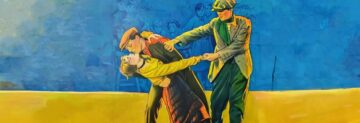 Traditionally, love is seen as a profound and enduring connection. Yet, as Lacan and Deleuze describe, love is also a mad compulsion where we throw ourselves repeatedly against the wall between self and other. Insofar as love is necessary, Sinan Richards writes, it lies in identifying and seeking this madness in each other, and embracing imperfection. While writing The Dialectics of Love in Sartre and Lacan, I was living and teaching in Paris and would often travel to London by train to see friends and family. On one such trip, I was asked by a British Border Force agent at St Pancras International: ‘What is it that you do, then?’ When I explained that I was working on a book on Jean-Paul Sartre and Jacques Lacan and how love was impossible, the border guard retorted scornfully, ‘That’s the problem with you academics – you spend so much time thinking that you can’t get on with it.’ This exchange still makes me chuckle, because, although rude, what if he was right?
Traditionally, love is seen as a profound and enduring connection. Yet, as Lacan and Deleuze describe, love is also a mad compulsion where we throw ourselves repeatedly against the wall between self and other. Insofar as love is necessary, Sinan Richards writes, it lies in identifying and seeking this madness in each other, and embracing imperfection. While writing The Dialectics of Love in Sartre and Lacan, I was living and teaching in Paris and would often travel to London by train to see friends and family. On one such trip, I was asked by a British Border Force agent at St Pancras International: ‘What is it that you do, then?’ When I explained that I was working on a book on Jean-Paul Sartre and Jacques Lacan and how love was impossible, the border guard retorted scornfully, ‘That’s the problem with you academics – you spend so much time thinking that you can’t get on with it.’ This exchange still makes me chuckle, because, although rude, what if he was right?
Between 1988 and 1989, while filming L’Abécédaire, Gilles Deleuze linked a fundamental aspect of love to madness. Deleuze says: ‘if you don’t get the little kernel of madness in someone, then you can’t love them. If you don’t seize their point of insanity, you fall short. The location of someone’s insanity is the source of all their charm.’ Deleuze is right: there is a remarkably close proximity between madness and love, and this was also true for Lacan.
More here.
Consciousness, Creativity, and Godlike AI
Steve Paulson in Nautilus:
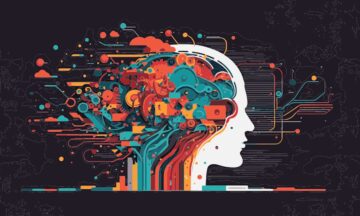 These days, we’re inundated with speculation about the future of artificial intelligence—and specifically how AI might take away our jobs, or steal the creative work of writers and artists, or even destroy the human species. The American writer Meghan O’Gieblyn also wonders about these things, and her essays offer pointed inquiries into the philosophical and spiritual underpinnings of this technology. She’s steeped in the latest AI developments but is also well-versed in debates about linguistics and the nature of consciousness. O’Gieblyn also writes about her own struggle to find deeper meaning in her life, which has led her down some unexpected rabbit holes. A former Christian fundamentalist, she later stumbled into transhumanism and, ultimately, plunged into the exploding world of AI. (She currently also writes an advice column for Wired magazine about tech and society.)
These days, we’re inundated with speculation about the future of artificial intelligence—and specifically how AI might take away our jobs, or steal the creative work of writers and artists, or even destroy the human species. The American writer Meghan O’Gieblyn also wonders about these things, and her essays offer pointed inquiries into the philosophical and spiritual underpinnings of this technology. She’s steeped in the latest AI developments but is also well-versed in debates about linguistics and the nature of consciousness. O’Gieblyn also writes about her own struggle to find deeper meaning in her life, which has led her down some unexpected rabbit holes. A former Christian fundamentalist, she later stumbled into transhumanism and, ultimately, plunged into the exploding world of AI. (She currently also writes an advice column for Wired magazine about tech and society.)
When I visited her at her home in Madison, Wisconsin, I was curious if I might see any traces of this unlikely personal odyssey. I hadn’t expected her to pull out a stash of old notebooks filled with her automatic writing, composed while working with a hypnotist. I asked O’Gieblyn if she would read from one of her notebooks, and she picked this passage: “In all the times we came to bed, there was never any sleep. Dawn bells and doorbells and daffodils and the side of the road glaring with their faces undone …” And so it went—strange, lyrical, and nonsensical—tapping into some part of herself that she didn’t know was there.
More here.
Wednesday Poem
Too Many Names
Mondays are meshed with Tuesdays
and the whole week with the whole year.
Time cannot be cut
with your exhausted scissors,
and all the names of the day
are washed out by the waters of night.
No one can claim the name of Pedro,
nobody is Rosa or Maria,
all of us are dust or sand,
all of us are rain under rain.
They have spoken to me of Venezuelas,
of Chiles and Paraguays;
I have no idea what they are saying.
I know only the skin of the earth
and I know it has no name.
When I lived amongst the roots
they pleased me more than flowers did,
and when I spoke to a stone
it rang like a bell.
It is so long, the spring
which goes on all winter.
Time lost its shoes.
A year lasts four centuries.
When I sleep every night,
what am I called or not called?
And when I wake, who am I
if I was not I while I slept?
This means to say that scarcely
have we landed into this life
than we come as if new-born;
let us not fill our mouths
with so many faltering names,
with so many sad formalities,
with so many pompous letters,
with so much of yours and mine,
with so much signing of papers.
I have a mind to confuse things,
unite them, make them new-born,
mix them up, undress them,
until all light in the world
has the oneness of the ocean,
a generous, vast wholeness,
a crackling, living fragrance.
by Pablo Neruda
from Poetic Outlaws
Tuesday, May 7, 2024
The eccentric volunteers who helped make the OED
David Skinner in Commonweal:
 Although the dictionary was not founded at the university, the OED might be described as the Oxford of dictionaries, so revered is it among reference works and books in general. It is the gold standard of academic English-language lexicography and a key tool behind many research projects into the history of English, including many other dictionaries. “It is as unthinkable that any contemporary lexicographer be without the OED,” wrote Sidney Landau in Dictionaries: The Art and Craft of Lexicography, first published in 1984, “as it is that a professional photographer fail to own a tripod to support his camera when needed.”
Although the dictionary was not founded at the university, the OED might be described as the Oxford of dictionaries, so revered is it among reference works and books in general. It is the gold standard of academic English-language lexicography and a key tool behind many research projects into the history of English, including many other dictionaries. “It is as unthinkable that any contemporary lexicographer be without the OED,” wrote Sidney Landau in Dictionaries: The Art and Craft of Lexicography, first published in 1984, “as it is that a professional photographer fail to own a tripod to support his camera when needed.”
A New English Dictionary on Historical Principles, as it was originally called, expounded a new model for dictionaries—the historical dictionary—teaching readers, many for the first time, to think of linguistic form and meaning as historically mutable. Words change—this is the OED’s great lesson, taught one dictionary entry at a time.
More here.
Alien life is no joke
Adam Frank in Aeon:
 Suddenly, everyone is talking about aliens. After decades on the cultural margins, the question of life in the Universe beyond Earth is having its day in the sun. The next big multibillion-dollar space telescope (the successor to the James Webb) will be tuned to search for signatures of alien life on alien planets and NASA has a robust, well-funded programme in astrobiology. Meanwhile, from breathless newspaper articles about unexplained navy pilot sightings to United States congressional testimony with wild claims of government programmes hiding crashed saucers, UFOs and UAPs (unidentified anomalous phenomena) seem to be making their own journey from the fringes.
Suddenly, everyone is talking about aliens. After decades on the cultural margins, the question of life in the Universe beyond Earth is having its day in the sun. The next big multibillion-dollar space telescope (the successor to the James Webb) will be tuned to search for signatures of alien life on alien planets and NASA has a robust, well-funded programme in astrobiology. Meanwhile, from breathless newspaper articles about unexplained navy pilot sightings to United States congressional testimony with wild claims of government programmes hiding crashed saucers, UFOs and UAPs (unidentified anomalous phenomena) seem to be making their own journey from the fringes.
What are we to make of these twin movements, the scientific search for life on one hand, and the endlessly murky waters of UFO/UAP claims on the other? Looking at history shows that these two very different approaches to the question of extraterrestrial life are, in fact, linked, but not in a good way.
More here.
50 Completely True Things
Mo Husseini writes:
I wanted to share a (not exhaustive) list of 50 useful and indisputable facts on the Palestinian / Israeli conflict.
FACT No. 1.
Some Jews are shitty and awful people.
FACT No. 2.
Some Muslims are shitty and awful people.
FACT No. 3.
Some Christians are shitty and awful people.
FACT No. 4.
Some Arabs are shitty and awful people.
FACT No. 5.
Some Americans are shitty and awful people.
More here.
Scott Galloway: How the US is destroying young people’s future
A new age: Pittsburgh-based author chronicles science’s search for human immortality
Bill Driscoll in witf:
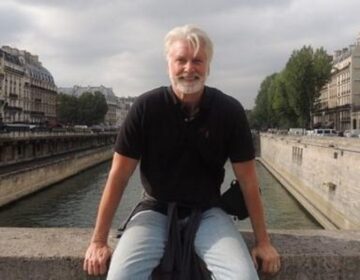 Chip Walter’s new book is titled “Immortality Inc.: Renegade Science, Silicon Valley Billions and the Quest to Live Forever.” It’s about the money, and the research, that’s seeking a way to extend human life indefinitely. Sounds like science fiction, but Walter thinks breakthroughs are just around the corner. “I think it’s going to begin to happen in the next five years,” said the Pittsburgh-based science writer in a recent interview.
Chip Walter’s new book is titled “Immortality Inc.: Renegade Science, Silicon Valley Billions and the Quest to Live Forever.” It’s about the money, and the research, that’s seeking a way to extend human life indefinitely. Sounds like science fiction, but Walter thinks breakthroughs are just around the corner. “I think it’s going to begin to happen in the next five years,” said the Pittsburgh-based science writer in a recent interview.
As the term “renegade science” suggests, efforts to “cure death,” as Walters puts it, remain something of a fringe enterprise. But given that the likes of Google and Apple are backing work by scientific visionaries, Walter is convinced they won’t be for long. And his 300-page book doesn’t seem to be dwelling on the fringes: Walter is a former CNN bureau chief with other respected science books to his credit, and “Immortality, Inc.,” published by National Geographic, is getting respectful reviews from the likes of Publishers’ Weekly.
The project started several years ago, when Walter recalls magazines running cover stories on research that had the much more modest goal of helping people live to 120 or so. At the time, he didn’t find the prospects for such lab work especially bright. That changed in 2013, when he learned that Google and Apple were getting into the game. “And you went, ‘OK, now it’s serious,’” he said. “That was to me a huge turning point because there was some serious credibility behind that. It wasn’t just snake oil.”
More here.
Hacking the immune system could slow ageing — here’s how
Alison Abbott in Nature:
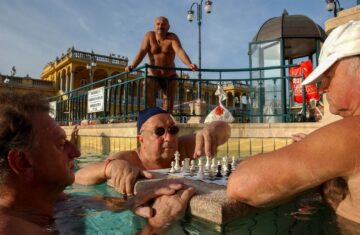 Stem-cell researcher Carolina Florian didn’t trust what she was seeing. Her elderly laboratory mice were starting to look younger. They were more sprightly and their coats were sleeker. Yet all she had done was to briefly treat them — many weeks earlier — with a drug that corrected the organization of proteins inside a type of stem cell. When technicians who were replicating her experiment in two other labs found the same thing, she started to feel more confident that the treatment was somehow rejuvenating the animals. In two papers, in 2020 and 2022, her team described how the approach extends the lifespan of mice and keeps them fit into old age1,2.
Stem-cell researcher Carolina Florian didn’t trust what she was seeing. Her elderly laboratory mice were starting to look younger. They were more sprightly and their coats were sleeker. Yet all she had done was to briefly treat them — many weeks earlier — with a drug that corrected the organization of proteins inside a type of stem cell. When technicians who were replicating her experiment in two other labs found the same thing, she started to feel more confident that the treatment was somehow rejuvenating the animals. In two papers, in 2020 and 2022, her team described how the approach extends the lifespan of mice and keeps them fit into old age1,2.
The target of Florian’s elixir is the immune system. The stem cells she treated are called haematopoietic, or blood, stem cells (HS cells), which give rise to all immune cells. As blood circulates, the mix of cells pervades every organ, affecting all bodily functions. But the molecular composition of the HS cells changes with age, and this distorts the balance of immune cells that they produce. “Fixing the drift in them that occurs with time seems to fix a lot of the problems of ageing — not only in the immune system but also in the rest of the body,” says Florian, who is now at the Bellvitge Biomedical Research Institute in Barcelona, Spain. In March3, another team showed that restoring the balance between two key types of immune cell gives old mice more youthful immune systems, improving the animals’ ability to respond to vaccines and to stave off viral infections.
More here.
On Satire: John Gay’s ‘The Beggar’s Opera’
Vanessa Conte’s Depraved Zines
Alex Jovanovich at Artforum:
THE MARQUIS DE SADE rained hell upon his Justine, a fictional naïf whose virtuousness was relentlessly “tested” by every stripe of abuse and sexual atrocity the malveillante French author could dream up. Since her appearance more than two centuries ago, the character has spawned countless progeny. Among them is Amy, a young and voluptuous glutton for punishment invented by painter and comics artist Vanessa Conte, whose work for the past decade has been examining the role of the female figure within the realm of sadomasochistic fantasy. Amy: Thrill to Live, a black-and-white zine (with four-color cover) released by Random Man Editions in 2023, is the first collection of the titular underdog’s harrowing adventures.
Aesthetically, Amy is trapped in the mall-fashion amber of Long Island—where Conte, who is now based in Los Angeles, grew up—between the years 1986 and 1991: the ideal primal-scene milieu for an artist born in the late ’70s. Amy’s clothes, seemingly plucked off the rack from a Merry-Go-Round, call to mind the looks once offered by teen-favorite brands Generra, IOU, or B.U.M. Equipment. She also possesses a thick mane of hair, which is frequently teased into the fully dressed styles of her fulsome era.
more here.
The Forgotten Queens of Egypt
Antony Spawforth at Literary Review:
 Religion reinforced Ptolemaic queenship. The influential Egyptian priesthood and the Ptolemaic court were politically co-dependent. In discussing this relationship, the author makes skilful use of the art and hieroglyphs found in Egypt’s temples. These showcased favourably the role of the Ptolemaic queen, hedging it with a prestigious divinity. How much this ‘propaganda’ rubbed off on ordinary Egyptians is debatable. Llewellyn-Jones also highlights the colonialist and racist character of the Graeco-Macedonian occupation of Egypt and describes the so-called Great Revolt of around 199 BC. Setting southern Egypt alight, it was put down by Alexandria only after a real show of force.
Religion reinforced Ptolemaic queenship. The influential Egyptian priesthood and the Ptolemaic court were politically co-dependent. In discussing this relationship, the author makes skilful use of the art and hieroglyphs found in Egypt’s temples. These showcased favourably the role of the Ptolemaic queen, hedging it with a prestigious divinity. How much this ‘propaganda’ rubbed off on ordinary Egyptians is debatable. Llewellyn-Jones also highlights the colonialist and racist character of the Graeco-Macedonian occupation of Egypt and describes the so-called Great Revolt of around 199 BC. Setting southern Egypt alight, it was put down by Alexandria only after a real show of force.
By the time he gets to her, in chapter fifteen, Llewellyn-Jones has established that the famous Cleopatra, the seventh of that name, certainly had family history on her side – not all of it edifying – in gauging how to play the part of Ptolemaic queen regnant.
more here.
Tuesday Poem
Older Love
His wife has asthma
so he only smokes outdoors
or late at night with head
and shoulders well into
the fireplace, the mesquite and oak
heat bright against his face.
Does it replace the heat
that has wandered from love
back into the natural world?
But then the shadow passion casts
is much longer than passion,
stretching with effort from year to year.
Outside tonight hard wind and sleet
from three bald mountains,
and on the hearth before his face
the ashes we’ll all become,
soft as the back of a woman’s knee.
by Jim Harrison
from Poetic Outlaws
Sunday, May 5, 2024
What would culture look like without nightlife?
Rebecca Nicholson in The Guardian:
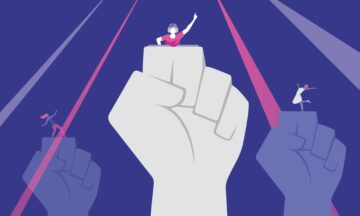 To answer the question of what we’re losing, think about what nightlife has given us. It was always a haven for outsiders trying to find, establish or shape their own communities. It brings people together and remains an insistently communal experience in an increasingly individualistic and closed-off late capitalist society. Gigs and clubs require us to be together – as friends, but also with those we don’t know. Luis Manuel Garcia-Mispireta, an academic who researches dance-music scenes, calls this “stranger-intimacy”.
To answer the question of what we’re losing, think about what nightlife has given us. It was always a haven for outsiders trying to find, establish or shape their own communities. It brings people together and remains an insistently communal experience in an increasingly individualistic and closed-off late capitalist society. Gigs and clubs require us to be together – as friends, but also with those we don’t know. Luis Manuel Garcia-Mispireta, an academic who researches dance-music scenes, calls this “stranger-intimacy”.
Nights out are not always utopian, of course. Hedonism can lead to trouble of the negative kind, but it can also lead to trouble that changes the world. After dark, revelations and revolutions happen. Marginalised communities have found freedom in nightlife, and gone on to push that freedom into the daylight. People who were at the Stonewall riots say that their protest emerged from an insistence on the right to dance freely.
More here.
How a NASA Probe Solved a Scorching Solar Mystery
Thomas Zurbuchen in Quanta:
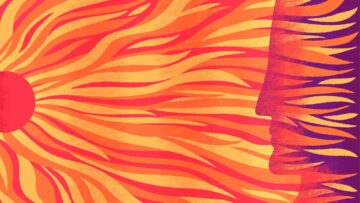 Our sun is the best-observed star in the entire universe.
Our sun is the best-observed star in the entire universe.
We see its light every day. For centuries, scientists have tracked the dark spots dappling its radiant face, while in recent decades, telescopes in space and on Earth have scrutinized sunbeams in wavelengths spanning the electromagnetic spectrum. Experiments have also sniffed the sun’s atmosphere, captured puffs of the solar wind, collected solar neutrinos and high-energy particles, and mapped our star’s magnetic field — or tried to, since we have yet to really observe the polar regions that are key to learning about the sun’s inner magnetic structure.
For all that scrutiny, however, one crucial question remained embarrassingly unsolved. At its surface, the sun is a toasty 6,000 degrees Celsius. But the outer layers of its atmosphere, called the corona, can be a blistering — and perplexing — 1 million degrees hotter.
More here.
Indian Court Painting and an Eclipse
Morgan Meis at Slant Books:
 I was meeting my mother at the museum. My mother is both a great lover of art and completely unpretentious about it. Often, she simply stands in front of objects of art and smiles. We found ourselves in an exhibit entitled Indian Skies: The Howard Hodgkin Collection of Indian Court Painting. We were both suddenly astonished. I don’t know why exactly. I do know why un-exactly. The paintings are extraordinary. But what does that mean? I don’t know. I don’t know anything about Indian Court paintings. I’ve seen a few here and there, including some in India. But I don’t know how to look at them. I don’t know the history or the context or the way that these paintings fit into a narrative. I don’t know the codes. So I just looked, without context, without codes.
I was meeting my mother at the museum. My mother is both a great lover of art and completely unpretentious about it. Often, she simply stands in front of objects of art and smiles. We found ourselves in an exhibit entitled Indian Skies: The Howard Hodgkin Collection of Indian Court Painting. We were both suddenly astonished. I don’t know why exactly. I do know why un-exactly. The paintings are extraordinary. But what does that mean? I don’t know. I don’t know anything about Indian Court paintings. I’ve seen a few here and there, including some in India. But I don’t know how to look at them. I don’t know the history or the context or the way that these paintings fit into a narrative. I don’t know the codes. So I just looked, without context, without codes.
More here.
On Jacob Israël de Haan’s Palestine and Arnold Zweig’s novel of post‑Zionist disillusionment
Sudeep Dasgupta in the European Review of Books:
 Palestine, before it named something else, named a region. The region emerged during Ottoman rule, between 1518 and 1920. It was called Filastin in Arabic, the language of the Muslims, Christians, Jews and others who lived in this region. The word « Palestinians » could apply to all of them. It could refer to « Palestinians » beyond Palestine, too, as when Immanuel Kant, for example, referred to European Jews in 1798 as « Palestinians living among us » in his Anthropology from a Pragmatic Point of View. This is one of many things we’ve forgotten to remember.
Palestine, before it named something else, named a region. The region emerged during Ottoman rule, between 1518 and 1920. It was called Filastin in Arabic, the language of the Muslims, Christians, Jews and others who lived in this region. The word « Palestinians » could apply to all of them. It could refer to « Palestinians » beyond Palestine, too, as when Immanuel Kant, for example, referred to European Jews in 1798 as « Palestinians living among us » in his Anthropology from a Pragmatic Point of View. This is one of many things we’ve forgotten to remember.
Jews in the late-nineteenth-century Ottoman Empire, meanwhile, identified as Ottoman citizens, and, in the Empire’s Arab-speaking regions, as Arab. « Arab » could encompass Muslims, Christians, Druzes, Alevis and Jews. Another thing we’ve forgotten to remember is an intimate relationality — Muslims, Jews, Christians and others — forged within the Ottoman project by those in Palestine and beyond, long before our time. As the Ottoman Empire fractured in the early twentieth century and collapsed after World War I, the term « Arab » would acquire an increasingly political or nationalist edge.
More here.
Why science needs metaphor
Tasneem Zehra Husain in New Humanist:
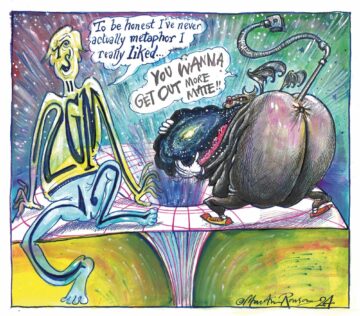 If science has a native tongue, it is mathematics. Equations capture, precisely, the relationships among the elements of a system; they allow us to pose questions and calculate answers. Numerically, these answers are precise and unambiguous – but what happens when we want to know what our calculations mean? Well, that is when we revert to our own native tongue: metaphor.
If science has a native tongue, it is mathematics. Equations capture, precisely, the relationships among the elements of a system; they allow us to pose questions and calculate answers. Numerically, these answers are precise and unambiguous – but what happens when we want to know what our calculations mean? Well, that is when we revert to our own native tongue: metaphor.
Why metaphor? Because that is how we think, how learn, how we parse the world. Metaphor comes from the Greek metaphora, a “transfer”; literally a “carrying over”. The very act of understanding (from the Old English: to stand in the midst of) implies the existence of a “between”, a bridge between new and known. In effect, a metaphor. How could it be otherwise? How else can we assimilate a new piece of knowledge, other than by linking it to something we already know? In doing so, we weave a web. When we wonder what something means, what we’re really asking is: what will it impact? If I pull on this thread here, where will my web tighten, where might it unravel?
When we can’t find a suitable metaphor to describe our scientific reality, we run into problems. Take, for instance, quantum mechanics. Most of the devices we use every day are built upon eerily accurate calculations made using quantum theory. Operationally, the theory is wildly successful, yet no one can make complete sense of it. Even scientists who wield the equations with ease don’t claim to truly understand quantum theory; we still don’t have a metaphor that works.
More here.
